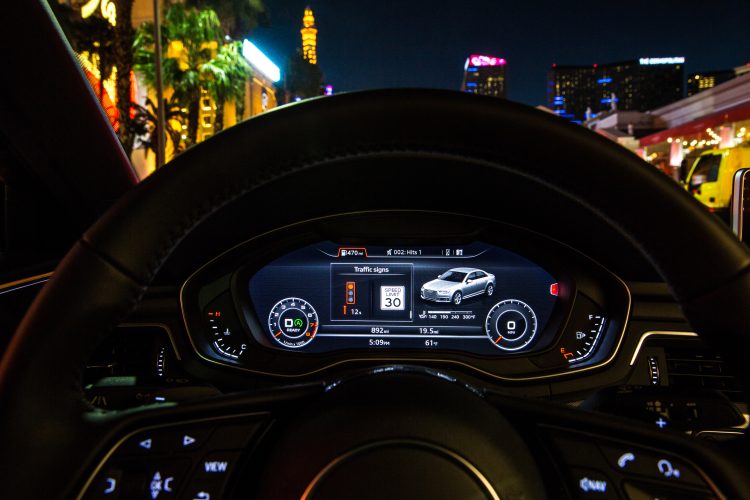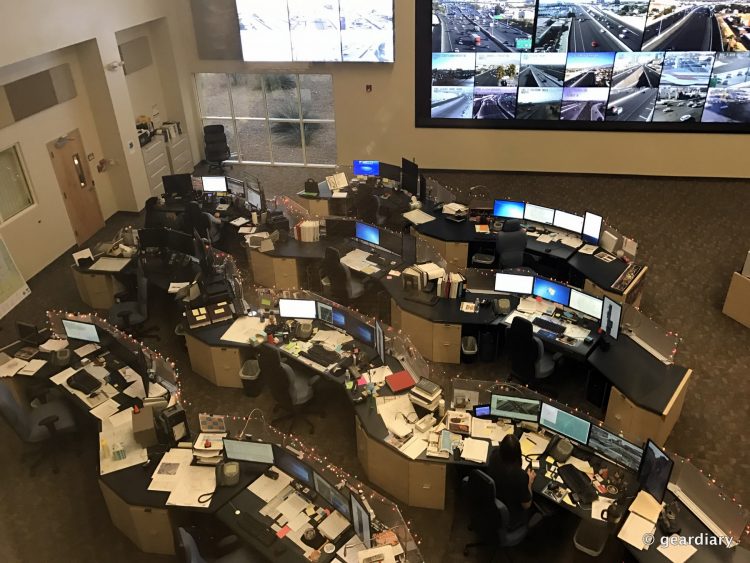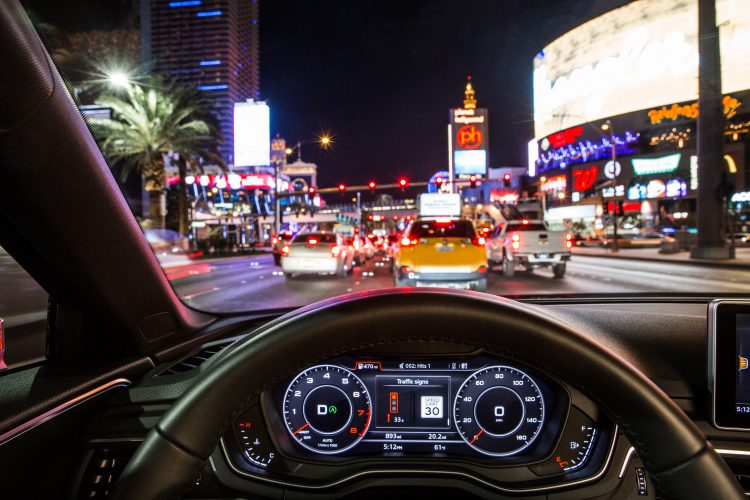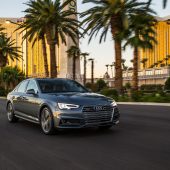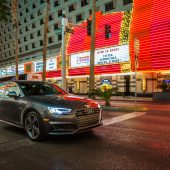This week I got a chance to try a new and exciting technology that was already present and built into several 2017 Audi models since June 1 but had just come online. V2I, or Vehicle to Infrastructure, Traffic Light Information is built into the Audi A4, Q7, and allroad models; the first city to offer it is Las Vegas, Nevada.
Long story short, through communication between the vehicle and the city’s infrastructure, the car is able to receive real-time information from the “advanced traffic management system that monitors traffic lights via the onboard 4G LTE data connection. Las Vegas happens to be one of the first US cities that has a sophisticated central management system in place, and we were invited in to take a look behind the scenes.
This FAST command center is inside the Regional Transportation Commission (RTC) of Southern Nevada. FAST stands for Freeway & Arterial System of Transportation. In here, more than 500 cameras that are placed all over the southern part of Nevada (not just the city of Las Vegas), allow the monitoring and control of traffic through the “use of traffic signals, ramp meters, dynamic message signs, and lane use control signals.” For instance, if there is an emergency vehicle that needs to get through a route quickly, FAST operators inside the RTC can make that happen. You can see that there are views from many cameras which have been placed at points along the highways; from this RTC command center, they can easily monitor what’s going on.
It was in this setting that I, along with a few other writers, was made privy to the idea behind Traffic Light Information, an Audi connect PRIME feature.
The way Traffic Light Information works is that as you approach a red traffic light, TLI will indicate the time remaining until the traffic signal light turns green. You’ll see that information displayed not only in the driver’s information cluster but also in the Audi driver’s heads up display (in so equipped vehicles).
Now, before you start thinking that this is some new technology that will give drivers an excuse to pay even less attention to the road or their surroundings, you need to understand that that’s not the idea here at all, and that’s not how this works.
Think about how many times you’ve pulled up to a traffic light; if you knew exactly how much time you had before the light switched to green, you would know whether or not you had time to enter a new location into your car’s GPS, for instance, or you’d know if you had enough time to reach behind you and hand something to a passenger. You wouldn’t have that slightly anxious feeling that you get when parked at a light — especially when you’re at the front the traffic — that you might miss the light turning green. It may seem like a little thing, but as I learned while using it, it’s rather convenient and definitely stress-reducing.
It’s worth noting that the display on your dash doesn’t show a green light as the light changes from red; having Traffic Light Information isn’t an excuse to gun the engine without looking around the minute the countdown stops. Rather, it’s simply a timer allowing you to see how long you’ve got left at a particular light. The timer will count down, and the screen will go blank before the light changes — which is your cue to pay attention (if you weren’t already) and watch for the light to change.
Side note: I was slightly shocked to learn that the lights on the Las Vegas Strip are timed to make you wait for a smidge under two minutes. That seems like forever when you are sitting there! But when you know exactly how much time you have to wait, it’s oddly liberating.

These are the traffic lights in the city of Las Vegas that are online and returning information back to the RTC. Crazy, right?
I wasn’t in the vehicle that experienced this, but while we were on our test drive, several A4 drivers were in the path of an ambulance that was approaching. They actually saw the red light information on their dashes reset itself to reflect the new red light time as the RTS was changing lights to allow the emergency vehicle to come through; that’s pretty cool. I’d like to eventually see a warning flash on the dashboard that alerts the driver to watch for the emergency vehicle; perhaps one day that will be possible.
Of course, Traffic Light Information is not a substitute for being present and paying attention while driving, and driver convenience isn’t the only thing that makes this feature attractive. Using this V2I technology will allow smart cities of the future to better understand traffic patterns; it could allow them to adapt traffic signal behavior to reduce congestion and improve traffic flow.
So how exactly does this technology work?
Audi and other car manufacturers have been working on providing and upgrading their vehicles’ connectivity for years. What’s also been happening at the same time is that cities have been doing a lot of investing in infrastructure — in being able to ensure that traffic lights are capable of being timed and managed in a coordinated way and that they are responsive to traffic situations. Cities have also begun to build centralized traffic management systems to control these lights.
Audi put forth the question of “how do you make two ecosystems that have been evolving independently and make them work with each other?”
Because “if all of that information is available in their [the cities infrastructure] universe, and all of this connectivity and capability is available in our [Audi’s] universe, what if we could take the information that they have and intelligently pass it to the car so that the car could inform the driver?”
Audi’s thought was “what if we could have a prediction of when the light would turn green and offer that to the customer. What would that do?” They ran experiments using that technology with customers, and they found that even when they didn’t tell the customer that it was something they were testing, that was the one thing that they wanted to talk about when they brought the car back — about how cool it was.
And so what Audi did was work with a company, Traffic Technology Services, that had essentially built a strong algorithm in the cloud to take live data coming from the city; they would then process that information and do predictions of when each traffic signal was going to turn green. They could do this for fixed time lights, for sure (because they are a given); fixed time lights have a static phase that’s predefined. But they could also do this for variable time lights — whether they were predefined variations or they were responsive to the sensors on the road and other camera positioning systems. This allowed the prediction algorithm to look at historical data, create a prediction for the future, and assign a confidence level to the prediction.
That information, on a second by second basis, is then relayed to the car; the car then uses that information to make a judgment call on whether or not to display the information to the driver. The information that would be displayed to the driver is how much time is left before the light turns green.
That information given to the driver will actually change based on the lane — whether you are in a straight lane or a turn lane — it will also change based on the distance you are from the traffic light; it will change based on whether or not you’re actually stopped at a traffic light and how long before the light actually turns green.
Audi markets this “time to green” convenience feature as “Traffic Light Information”; the car will display a clear icon that looks like a traffic light with an indication of a red stop light which tells you that the light is red and how many seconds it will be before the light changes to green. That countdown will continue in front of you, but it also tells you what the intersection looks like; for instance, if you are headed straight it might be 27 seconds before the light changes to green. If you are in a left turning lane, as I am in the picture below, it will update and tell you how many seconds before that signal will turn green based on you being in the turn lane.

Audi’s traffic light information knows which lane you are in and adjusts the time until the light turns green for your specific lane.
So in other words, what you used to have would be a driver sitting behind the wheel at a traffic light, hands on the wheel, looking at the traffic light, foot very close to the accelerator, and that was the position they would stay in until the light changed. Sometimes the driver would look at their watch — hoping that in the next few seconds the light will turn green — and as soon as the light finally turned green they’d be ready to go because no one want to be the guy who gets honked at.
“What Audi found is that with this technology, a lot of the behavior in the car changes to a more relaxed form of driving; you can see this in the driver when you sit beside them and you watch their behavior. If the driver can look at their dash and see that there are almost two minutes remaining until this light turns green, they might relax their hand positions, their shoulders relax, they might switch on a song and listen to the song, they might have time to take their coat off, they might have time to pick up that bottle that fell and hand it back to their child in the backseat, or maybe have a chat with the passenger. There are a lot of things that you can be doing while knowing fully that you aren’t really taking your attention away from the road because the display of the countdown is right there in front of you in the instrument cluster or in the heads up display. Audi looked at this, and they found it to be a more relaxed form of driving, and they see it as a key customer benefit. If you look at the sheer number of traffic lights that we have to go through in the course of a normal day, if you add up what happens — especially in rush hour — even a little bit of relief in those moments goes a long way. It’s a big deal.”
Audi calls this “informed waiting”, and it’s a way to reduce stress and enjoy a more relaxed form of driving. A key behavior Audi noted is that when drivers are approaching a signal and they don’t really know what it’s going to do, drivers tend to stay at a speed that will hopefully get them through the intersection before the light turns; if they judge incorrectly, sometimes they have to do a hard stop. “What this does, it will actually predict whether or not you’re going to make the intersection, and if you’re not going to make the intersection — even though the light is green — it will start showing you a red countdown. It’s essentially telling you that you’re not going to make it, you might as well take your foot off the accelerator and get prepared to slow down and stop. That’s the kind of driving behavior that not only relaxes, but it also ends up being important to how traffic flows in the city. It becomes a more efficient way of driving. This is also a technology that allows Audi to collect information that may be useful for the city to optimize their traffic management systems.”
None of this is possible, of course, without cities investing in their infrastructure and then Traffic Technology Services — the mind in the cloud that takes the information from the city — can develop the predictions for the algorithms, put confidence levels on them, and deliver them to Audi’s back-end; Audi’s back-end will then deliver it over the LTE connection to the car.
While this technology is currently only available in 2017 A4, Q7, and allroad models, Audi will be bringing Traffic Light Info capability to most of their new model lineup in the near future as part of their Audi connect PRIME services. This graphic gives you an idea of the features included in the different tiers of Audi connect …
Audi may be the first to use Traffic Light Information and V2I technology, and Las Vegas may be the first city to offer it, but it is not a closed system. V2I technology is available to all automotive manufacturers; Audi’s traffic light information just happens to be one of the first ways to implement it, and I definitely enjoyed the experience.
Audi wasn’t able to tell us which cities would be getting Traffic Light Information next, but if this list from Traffic Tech Services is any indication, it will be coming to many major cities soon.
Side note: This was my first time to drive an Audi in years … and the A4 sedan was a joy. It’s roomy, responsive, and full of impressive tech beyond what we were there to learn about.
- All photos in this group courtesy of Audi
Disclosure: Audi paid for my travel, room, and meals; there were no conditions or expectations made regarding what I chose to write about with regard to my experience.

